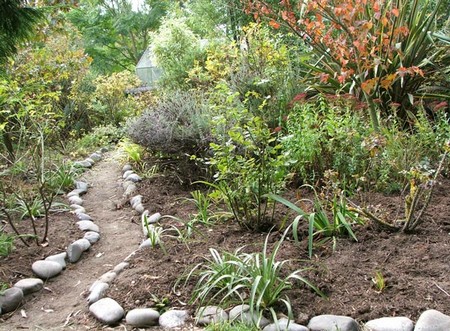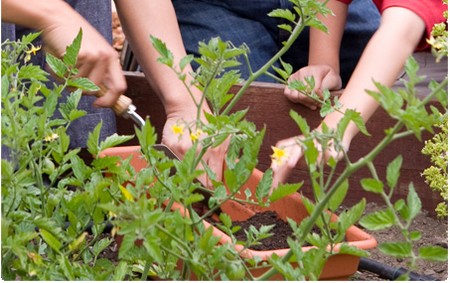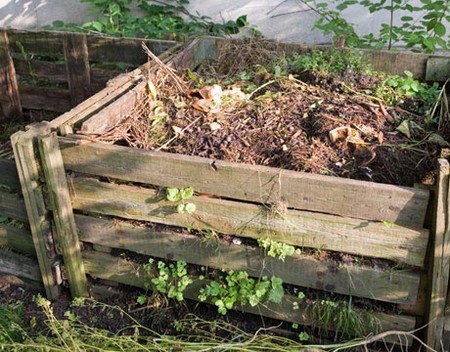Today the buzz word is compost. Composting involves piling layers of materials such as leaves, weeds, kitchen waste, lawn clippings, manure, spent plants, and a little soil, in such a way that they decompose into humus.
A compost pile may be just that—a pile of garden rubbish dumped behind a convenient hedge to get it out of the way. Discovered a year or two later, it turns out to have decayed and crumbled into a dark rich humus ready to be used in the garden. Accidental compost, you might say.
Rather than waiting for accidental composting, however, a thrifty gardener will set up a system that will yield a steady supply of compost. At the same time it disposes of all manner of waste that would otherwise be clogging landfills.
Kitchen waste is an important element in the home gardener’s composting program. What a good use for such things as spoiled greens, vegetable and fruit peelings, tea leaves, coffee grounds, eggshells, and all those good things that used to be put out to be carted away and incinerated!
There are some things that should not be put on the compost pile: fat, oil, or grease in quantity; dog or human feces; all of the contents of cat litter boxes. Furthermore, unless you’re planning an all-night snack bar for raccoons and other so-called varmints, don’t put meat and fish scraps on the pile. They have value, all right, and are used in big commercial composting operations, but they should not be used in small suburban yards where they could offend neighbors.
As more and more gardeners come to recognize the value of compost they look further afield for materials to add to their home supply. “Taking out the garbage” may become “bringing in the garbage.” In a recent exhaustive survey of composting techniques, Rodale Press suggests that you might strike a deal with your local pet store—you get the cage litter, bird droppings, and all, in exchange for cleaning out the bird cages. Now there’s a thought . . .
You can be as plain or as fancy as you like in your composting. I’ve seen catalogs with as many as four pages devoted to composting equipment. I must say I cringe a bit when, after all my talk about compost, students ask to see my composting setup. It’s a rudimentary framework of chicken wire stapled to old timbers and a few metal posts. It’s not that I wouldn’t like to have a good-looking, scientific compost bin—it’s just that I started with an improvisation and it still works, so a replacement is fairly low on my list of wants.
My setup gives me a large bin with two sections, open to the front. The vegetable matter goes into one section in layers until the pile is about four feet high. In summer, the warmth accelerates the decomposition process and, in a few weeks, I turn the pile over into the other section so that the top—the least decomposed part—becomes the bottom. Now I can start a new pile in the first section of the bin.
My compost area is in partial shade, hidden from the house by shrubbery and reached by a path wide enough for a large garden cart. I chose the site for esthetic reasons, but I do wish it were not so sharply uphill from every part of the garden. A cartload of plant material and damp soil is heavy and the temptation to pitch it over the wall is very strong. Put yours where you can get to it easily, or you won’t use it as often as you should.
In my part of the world there is little or no decomposition in the cold months of winter (I sometimes find the center of the compost pile still frozen solid in early May). Because my system is a bit haphazard, the internal temperature of the pile is not high enough to destroy weed seeds. I can just imagine the proliferation of weeds if I were to do what is often recommended and spread it on top of the ground like a mulch. I put my compost underground, where it works wonders.
Using the Compost
Each spring, I buy a good many one-year-old perennials and line them out in the production garden. I want them to grow quickly but not at the expense of strength. At this stage they are small, with modest root systems and, since they will be in this first location for only a month or so, I can plant them quite close together. I line the bottom of each hole with a trowelful of compost, put a little soil on top of that, and set the young plant on it. I know for a certainty that because of that compost the plants will make rapid and strong growth, starting with the roots.
I like my garden students to check out the progress for themselves. I enjoy seeing their amazement when they dig up these little perennials that they had planted only two or three weeks before. They see the remarkable root systems that have developed, with threadlike feeder roots penetrating and clinging to the fibrous compost. Seeing is believing.
I use compost for every single planting operation throughout the season. In fact, I make it a rule that not only should compost be at the bottom of any hole a plant is going into, but the hole it left behind should be filled with compost, too. And since, in a teaching garden, plants are moved frequently, this practice helps maintain the level and fertility of soil in the flower beds.
I’m not alone in this enthusiasm for compost. A friend of mine who had just sold her house understood, quite rightly, that the garden and all its plants would remain. “But,” she said vehemently, “they’re not getting the compost!” And they didn’t; she bagged it and took it with her. I fully expect to find in the newspaper one day that custody of the compost is a burning issue in some divorce settlement.
Categories
Advertisements
Recent Articles
 How to Understand Bed Sizes – A Small Guide
How to Understand Bed Sizes – A Small Guide How to Select Some Must Have Kitchen Accessories
How to Select Some Must Have Kitchen Accessories Best Way to Change a Car Tire
Best Way to Change a Car Tire Best Way to Write an Affirmation
Best Way to Write an Affirmation Best Way to Take Charge of Your Financial Life
Best Way to Take Charge of Your Financial Life Best Way to Survive a Party When You Don’t Know Anyone
Best Way to Survive a Party When You Don’t Know Anyone Best Way to Stop Self Sabotaging Yourself
Best Way to Stop Self Sabotaging Yourself Best Way to Start Journal Writing
Best Way to Start Journal Writing Best Way to Speak with a Powerful Voice
Best Way to Speak with a Powerful Voice Best Way to Simplify Your Life
Best Way to Simplify Your Life Best Way to Respond to a Put-Down
Best Way to Respond to a Put-Down Best Way to Reduce Acne Breakouts
Best Way to Reduce Acne Breakouts Best Way to Recover from Dining Disasters
Best Way to Recover from Dining Disasters Best Way to Quit Your Job Gracefully
Best Way to Quit Your Job Gracefully Best Way to Make Your Own Website
Best Way to Make Your Own Website




Leave a Reply